Influence of Fiber Deviation on Strength of Thin Birch (Betula pendula Roth.) Veneers
Abstract
1. Introduction
- Wide-angle X-ray scattering delivers reliable fiber deviations in two dimensions as well as at two hierarchical levels.
- A sound correlation between fiber deviation and ultimate tensile strength of the veneer can be achieved.
2. Materials and Methods
2.1. Sample Preperation
2.2. Sample Properties
2.3. Wide-Angle X-Ray Scattering (WAXS)
3. Results and Discussion
3.1. Sample Properties
3.2. Fiber Deviation
3.3. Fiber Deviation and Strength
4. Conclusions
Author Contributions
Funding
Acknowledgments
Conflicts of Interest
Appendix A
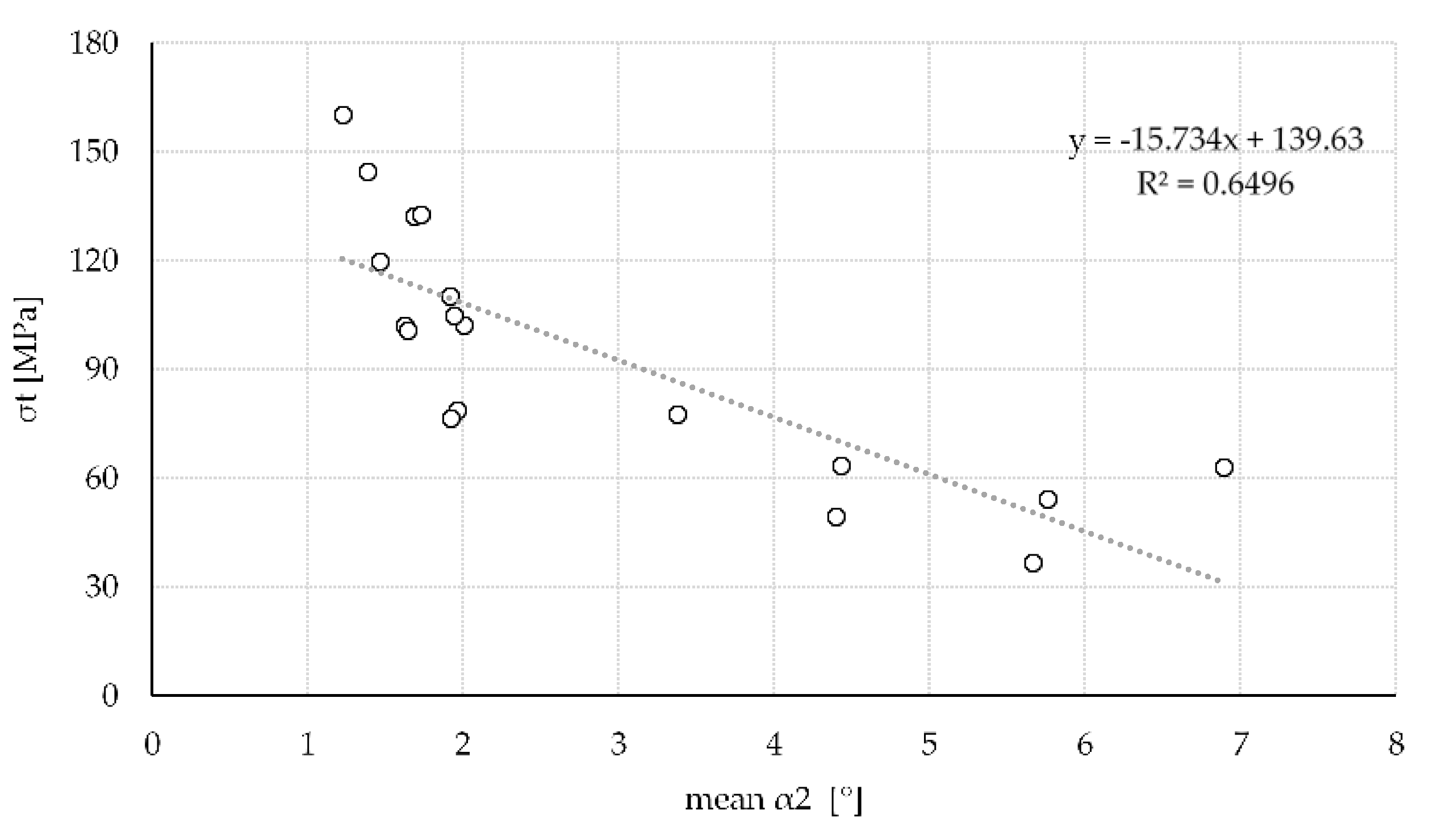

References
- Jost, T.; Müller, U.; Feist, F. Wood Composites for Future Automotive Engineering?—Basic Requirement: Crash Simulation of Wood-Based Components. Konstruktion 2018, 10, 74–82. [Google Scholar]
- Kohl, D.; Link, P.; Böhm, S. Wood as a Technical Material for Structural Vehicle Components. Proc. CIRP 2016, 40, 557–561. [Google Scholar] [CrossRef]
- Ross, R.J. Nondestructive Evaluation of Wood; United States Department of Agriculture: Madison, WI, USA, 2015. [Google Scholar]
- Bacher, M. Comparison of Different Machine Strength Grading Principles. In Proceedings of the COST E53 Conference, Delft, The Netherlands, 29–30 October 2008; pp. 183–193. [Google Scholar]
- Kollmann, F. Technologie Des Holzes Und Der Holzwerkstoffe, 2nd ed.; Springer: Berlin/Heidelberg, Germany, 1982. [Google Scholar]
- Niemz, P. Physik des Holzes und der Holzwerkstoffe; DRW-Verlag: Leinfelden-Echterdingen, Germany, 1993. [Google Scholar]
- Bodig, J.; Jayne, B.A. Mechanic of Wood and Wood Composites; Van Nostrand Reinhold: New York, NY, USA, 1982. [Google Scholar]
- Olsson, A.; Oscarsson, J.; Serrano, E.; Källsner, B.; Johansson, M.; Enquist, B. Prediction of Timber Bending Strength and In-Member Cross-Sectional Stiffness Variation on the Basis of Local Wood Fibre Orientation. Eur. J. Wood Wood Prod. 2013, 319–333. [Google Scholar] [CrossRef]
- Hanhijärvi, A.; Ranta-Maunus, A.; Turk, G. Potential of Strength Grading of Failure of Timber with Combined Measurement Techniques; VTT Technical Research Centre of Finland Ltd.: Espoo, Finland, 2005. [Google Scholar]
- Kelley, S.S.; Rials, T.G.; Groom, L.R.; So, C.-L. Use of near Infrared Spectroscopy to Predict the Mechanical Properties of Six Softwoods. Holzforschung 2004, 58, 252–260. [Google Scholar] [CrossRef]
- Viguier, J.; Bourgeay, C.; Rohumaa, A.; Pot, G.; Denaud, L. An Innovative Method Based on Grain Angle Measurement to Sort Veneer and Predict Mechanical Properties of Beech Laminated Veneer Lumber. Constr. Build. Mater. 2018, 181, 146–155. [Google Scholar] [CrossRef]
- Cha, J.K.; Pearson, R.G. Stress analysis and prediction in 3-layer laminated veneer lumber: Response to crack and grain angle. Wood Fiber Sci. 1994, 26, 97–106. [Google Scholar]
- Fujimoto, T.; Kawakami, K.; Aimi, H.; Shimizu, J.I.; Hasegawa, K.; Kobori, H.; Tsuchikawa, S. Prediction of Dry Veneer Stiffness Using near Infrared Spectra from Transverse Section of Green Log. J. Wood Sci. 2013, 59, 383–388. [Google Scholar] [CrossRef]
- Lang, E.M.; Bejo, L.; Divos, F.; Zsolt, K.; Anderson, B.R. Orthotropic Strength and Elasticity of Hardwoods in Relation to Composite Manufacture Part III: Orthoropic Elasticity of Structural Veneers. Wood Fiber Sci. 2003, 35, 307–320. [Google Scholar]
- Pramreiter, M.; Stadlmann, A.; Linkeseder, F.; Keckes, J.; Müller, U. Non-Destructive Testing of Thin Birch (Betula Pendula Roth.) Veneers. BioResources 2020, 15, 1265–1281. [Google Scholar]
- Braess, H.H.; Seiffert, U. Vieweg Handbuch Kraftfahrzeugtechnik; Vieweg + Teubner: Wiesbaden, Germany, 2012. [Google Scholar] [CrossRef]
- Müller, U.; Jost, T.; Kurzböck, C.; Stadlmann, A.; Wagner, W.; Kirschbichler, S.; Baumann, G.; Pramreiter, M.; Feist, F. Crash Simulation of Wood and Composite Wood for Future Automotive Engineering. Wood Mater. Sci. Eng. 2019, 1–13. [Google Scholar] [CrossRef]
- Müller, U.; Feist, F.; Jost, T. Holzverbundwerkstoffe Im Automobilbau Der Zukunft? Holztechnologie 2019, 1, 5–15. [Google Scholar]
- Kollmann, F.; Cote, W.A. Principles of Wood Science and Technology; Springer: Berlin/Heidelberg, Germany, 1968. [Google Scholar]
- Koskisen. Birch Veneer Grades. Available online: https://www.koskisen.com/file/birch-veneer-grades/?download (accessed on 17 March 2020).
- ISO 554. Normalklimate Für Die Konditionierung Und/Oder Prüfung: Anforderungen; International Organization for Standardization: Geneva, Switzerland, 1976.
- DIN 52182. Prüfung von Holz: Bestimmung Der Rohdichte; German Institute for Standardization: Berlin, Germany, 1976.
- DIN EN 789. Holzbauwerke—Prüfverfahren—Bestimmung Der Mechanischen Eigenschaften von Holzwerkstoffen; Deutsche Fassung; German Institute for Standardization: Berlin, Germany, 2005.
- Lichtenegger, H.; Reiterer, A.; Stanzl-Tschegg, S.E.; Fratzl, P. Determination of Spiral Angles of Elementary Fibrils on the Wood Cell Wall: Comparison of Small Angle X-Ray Scattering and Wide Angle X-Ray Diffraction. In Microfibril Angle in Wood; Butterfield, B.G., Ed.; University of Canterbury: Christcurch, New Zealand, 1998; pp. 140–156. [Google Scholar]
- Papula, L. Mathematik Für Ingenieure Und Naturwissenschaftler; Vieweg + Teubner: Wiesbaden, Germany, 2009. [Google Scholar]
- Sell, J. Eigenschaften Und Kenngrößen von Holzarten; Baufachverlag AG: Zürich, Switzerland, 1989. [Google Scholar]
- Wagenführ, R. Holzatlas, 6th ed.; Carl Hanser Verlag GmbH & Co. KG: Munich, Germany, 2006. [Google Scholar]
- Bonham, V.A.; Barnett, J.R. Fibre Length and Microfibril Angle in Silver Birch (Betula Pendula Roth). Holzforschung 2001, 55, 159–162. [Google Scholar] [CrossRef]
- Shigo, A.L. How Tree Branches Are Attached to Trunks.Pdf. Can. J. Bot. 1985, 63, 1391–1401. [Google Scholar] [CrossRef]
- Müller, U.; Gindl-Altmutter, W.; Keckes, J. How Softwood Tree Branches Are Attached to Stems: Hierarchical Extension of Shigo’s Stem-Branch Model. Trees 2018, 32, 1113–1121. [Google Scholar] [CrossRef]
- Hu, M.; Briggert, A.; Olsson, A.; Johansson, M.; Oscarsson, J.; Säll, H. Growth Layer and Fibre Orientation around Knots in Norway Spruce: A Laboratory Investigation. Wood Sci. Technol. 2018, 52, 7–27. [Google Scholar] [CrossRef]
- Richter, C. Wood Characteristics: Description, Causes, Prevention, Impact on Use and Technologgical Adaptaion; Springer international: Basel, Switzerland, 2015. [Google Scholar] [CrossRef]
- Schweingruber, F.H. Wood Structure and Environment; Springer: Berlin/Heidelberg, Germany, 2007. [Google Scholar]
- Senn, G. Über Die Ursachen Der Brettwurzel-Bildung Bei Der Pyramidenpappel. Verh. Nautrf. Ges. Basel 1923, 35, 405–435. [Google Scholar]
- Steege, H.; Welle, B.J.H.; Laming, P.B. The possible function of buttresses in caryocar nuciferum (caryocaraceae) in guyana: Ecological and wood anatomical observations. IAWA J. 1997, 18, 415–431. [Google Scholar] [CrossRef]
- Lima, J.T.; Breese, M.C.; Cahalan, C.M. Variation in Microfibril Angle in Eucalyptus Clones. Holzforschung 2004, 58, 160–166. [Google Scholar] [CrossRef]
- Donaldson, L. Microfibril Angle: Measurement, Variation and Relationships—A Review. IAWA J. 2008, 29, 345–386. [Google Scholar] [CrossRef]
- Lichtenegger, H.; Reiterer, A.; Stanzl-Tschegg, S.E.; Fratzl, P. Variation of Cellulose Microfibril Angles in Softwoods and Hardwoods—A Possible Strategy of Mechanical Optimization. J. Struct. Biol. 1999, 128, 257–269. [Google Scholar] [CrossRef]
- Barnett, J.R.; Bonham, V.A. Cellulose Microfibril Angle in the Cell Wall of Wood Fibres. Biol. Rev. Camb. Philos. Soc. 2004, 79, 461–472. [Google Scholar] [CrossRef] [PubMed]
- Fang, S.; Yang, W.; Tian, Y. Clonal and Within-Tree Variation in Microfibril Angle in Poplar Clones. New For. 2006, 31, 373–383. [Google Scholar] [CrossRef]
- Müller, U.; Gindl-Altmutter, W.; Konnerth, J.; Maier, G.A.; Keckes, J. Synergy of Multi-Scale Toughening and Protective Mechanisms at Hierarchical Branch-Stem Interfaces. Sci. Rep. 2015, 5, 1–9. [Google Scholar] [CrossRef] [PubMed]
- Foley, C. A Three-Dimensional Paradigm of Fiber Orientation in Timber. Wood Sci. Technol. 2001, 35, 453–465. [Google Scholar] [CrossRef]
- Stahl, D.; Cramer, S.; McDonald, K. Modeling the Effect of Out-of-Plane Fiber Orientation in Lumber Specimens. Wood Fiber Sci. 1989, 22, 173–192. [Google Scholar]
- Dinwoodie, J.M. Timber: Its Nature and Behaviour; Taylor & Francis: Abingdon, UK, 2001. [Google Scholar]
- Lukacevic, M.; Füssl, J.; Eberhardsteiner, J. Discussion of Common and New Indicating Properties for the Strength Grading of Wooden Boards. Wood Sci. Technol. 2015, 49, 551–576. [Google Scholar] [CrossRef]
- Wagenführ, A.; Scholz, F. Taschenbuch der Holztechnik, 2nd ed.; Carl Hanser Verlag GmbH & Co. KG: Munich, Germany, 2012. [Google Scholar]
- Hakinson, R.L. Investiagtion of Crushing Strength of Spruce at Varying Angles of Grain. Air Serv. Inf. Circ. 1921, 3, 259. [Google Scholar]
- Kollmann, F. Die Abhängigkeit Der Festigkeit Und Der Dehnungszahle Der Hölzer Vom Faserverlauf. Der Bauingenieur 1934, 19/20, 198–200. [Google Scholar]
- Hoffmann, O. The Brittle Strength of Orthotropic Materials. J. Compos. Mater. 1967, 1, 200–210. [Google Scholar] [CrossRef]
- Jones, R.M. Mechanics of Composite Materials; Taylor & Francis: Abingdon, UK, 1999. [Google Scholar] [CrossRef]
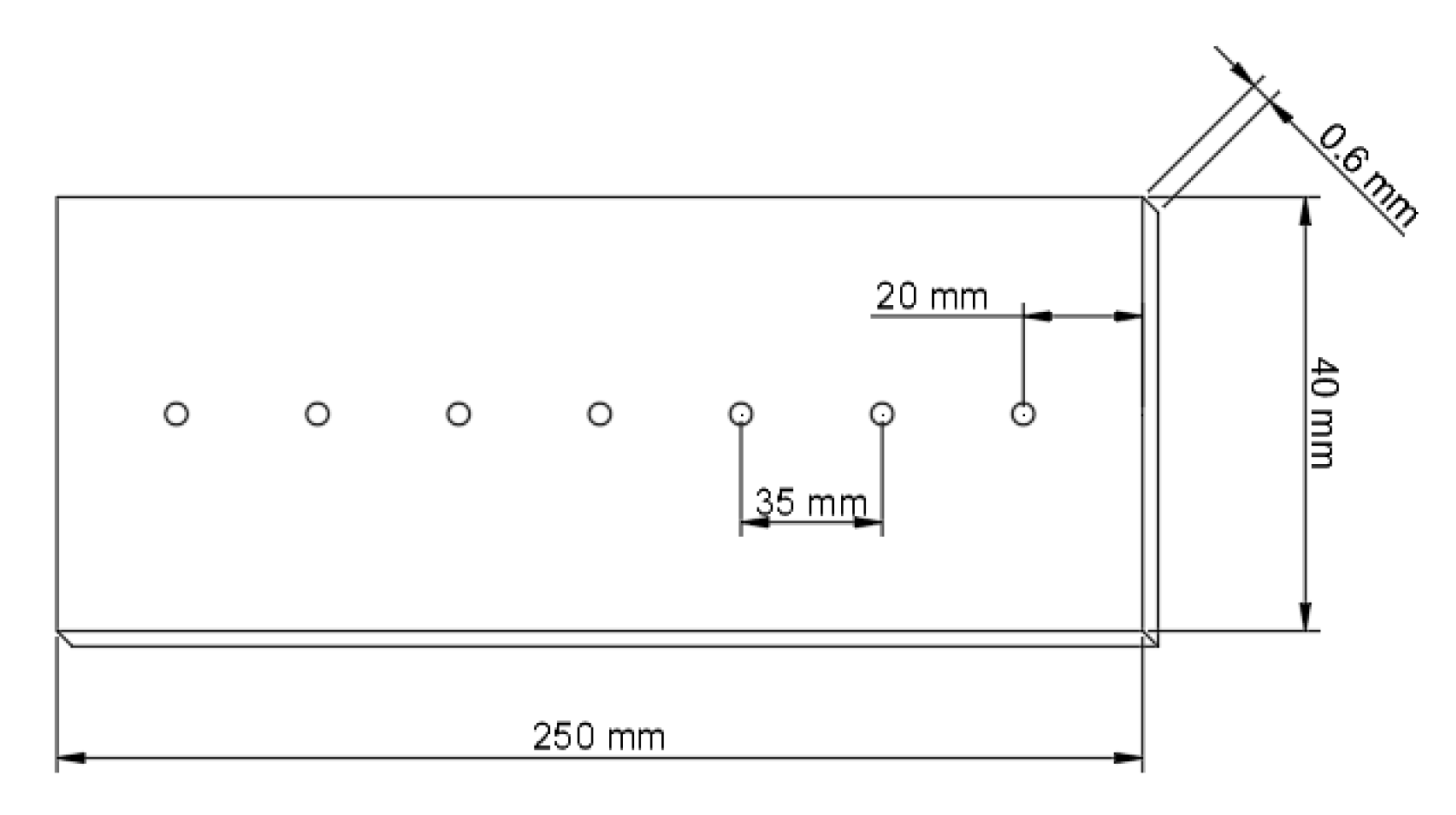
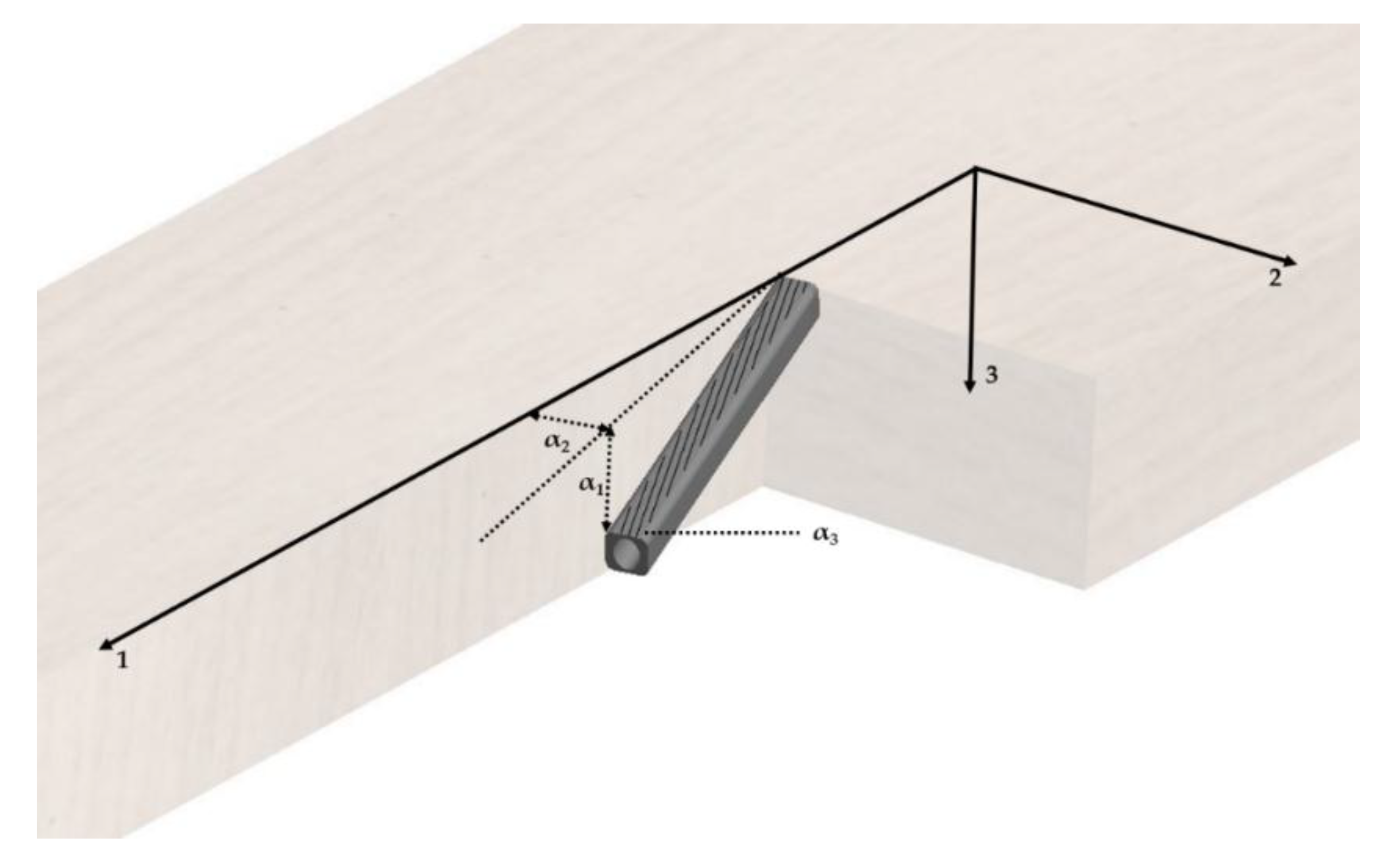
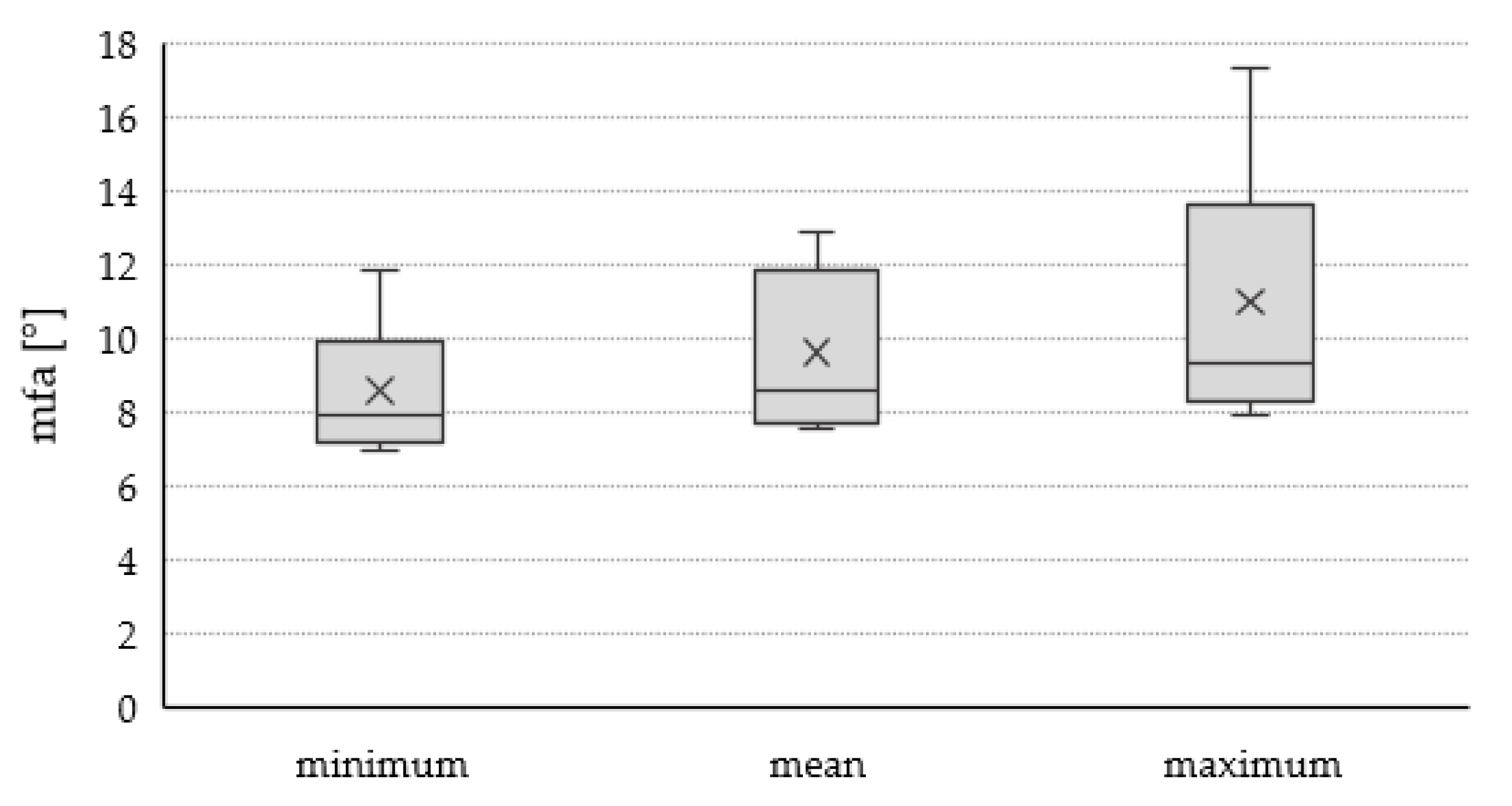

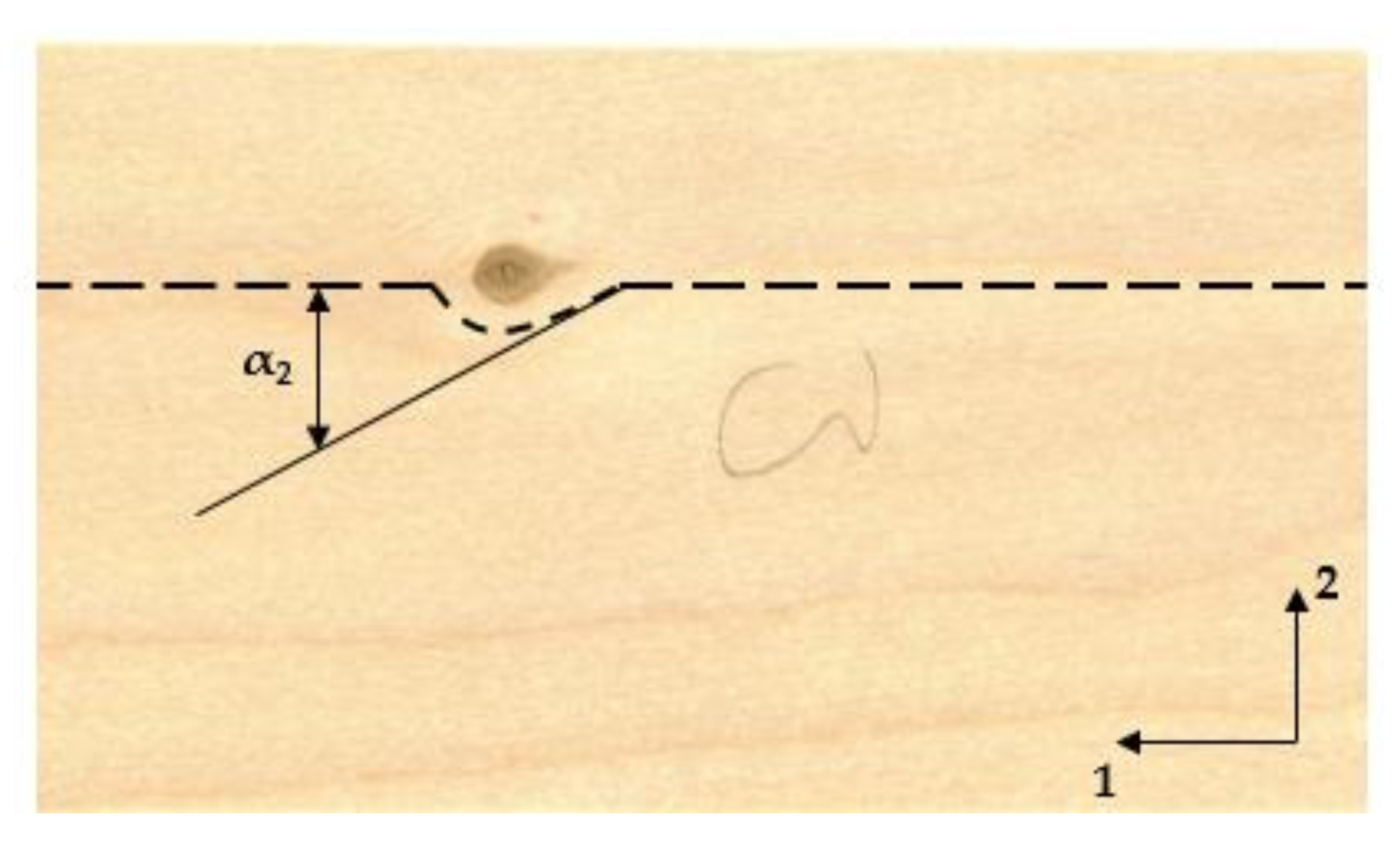

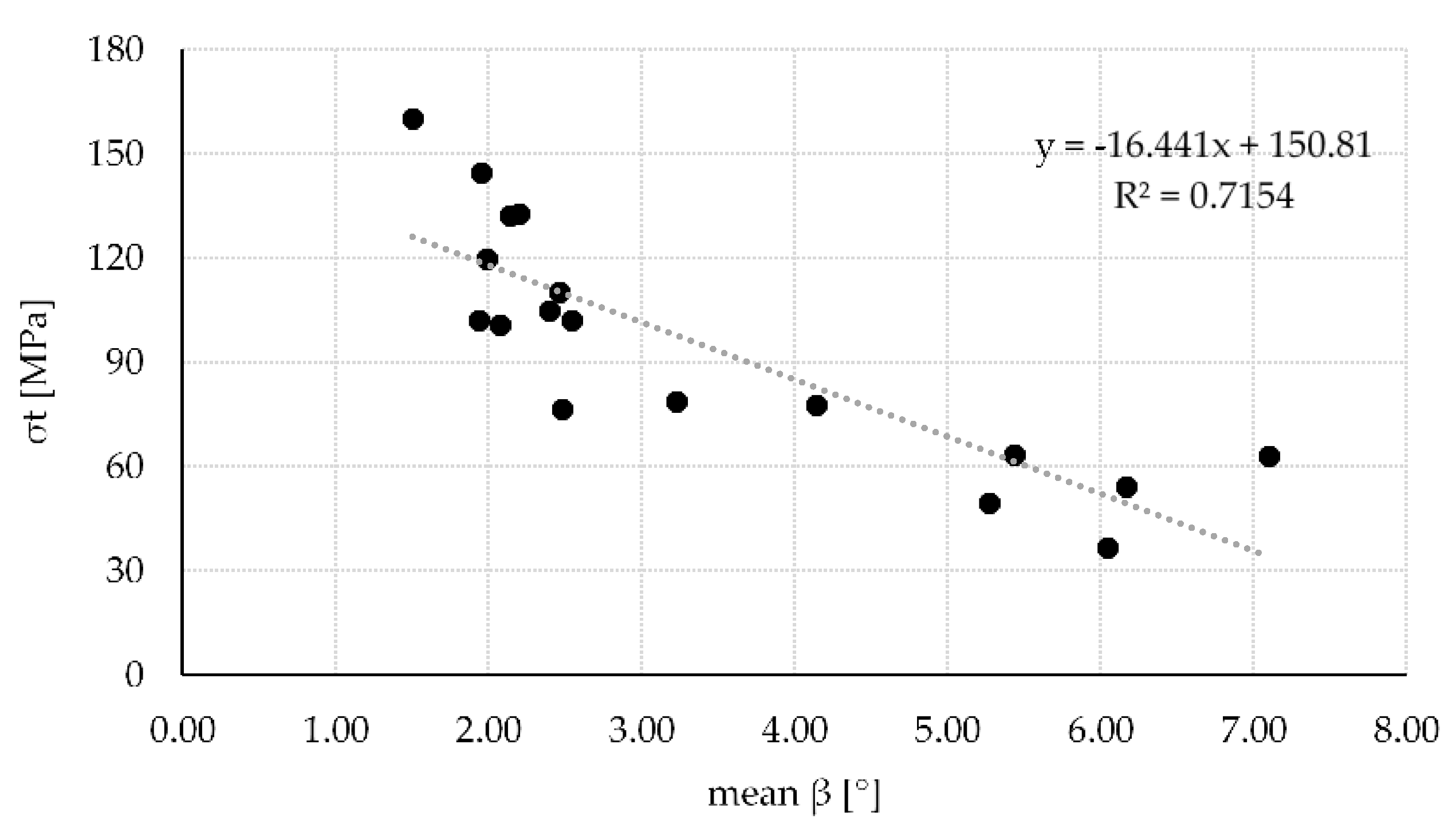
| Statistical Indicator | σt [MPa] | ρ [kg/m³] | mfa [°] | α1 [°] | α2 [°] | β [°] |
|---|---|---|---|---|---|---|
| n | 18 | 18 | 18 | 18 | 18 | 18 |
| mean | 95.03 | 605 | 9.61 | 1.61 | 2.83 | 3.39 |
| COV | 37% | 13% | 23% | 39% | 63% | 53% |
| min. | 36.76 | 469 | 7.54 | 0.79 | 1.22 | 1.50 |
| max. | 160.28 | 684 | 12.89 | 2.94 | 6.89 | 7.10 |
| Property | Min. Angle | Mean Angle | Max. Angle |
|---|---|---|---|
| σt [MPa] | 1 | 1 | 1 |
| ρ [kg/m³] | 0.551 | 0.551 | 0.551 |
| mfa [°] | −0.726 | −0.805 | −0.783 |
| α1 [°] | −0.663 | −0.762 | −0.594 |
| α2 [°] | −0.626 | −0.806 | −0.852 |
| β [°] | −0.735 | −0.846 | −0.818 |
© 2020 by the authors. Licensee MDPI, Basel, Switzerland. This article is an open access article distributed under the terms and conditions of the Creative Commons Attribution (CC BY) license (http://creativecommons.org/licenses/by/4.0/).
Share and Cite
Pramreiter, M.; Bodner, S.C.; Keckes, J.; Stadlmann, A.; Kumpenza, C.; Müller, U. Influence of Fiber Deviation on Strength of Thin Birch (Betula pendula Roth.) Veneers. Materials 2020, 13, 1484. https://doi.org/10.3390/ma13071484
Pramreiter M, Bodner SC, Keckes J, Stadlmann A, Kumpenza C, Müller U. Influence of Fiber Deviation on Strength of Thin Birch (Betula pendula Roth.) Veneers. Materials. 2020; 13(7):1484. https://doi.org/10.3390/ma13071484
Chicago/Turabian StylePramreiter, Maximilian, Sabine C. Bodner, Jozef Keckes, Alexander Stadlmann, Cedou Kumpenza, and Ulrich Müller. 2020. "Influence of Fiber Deviation on Strength of Thin Birch (Betula pendula Roth.) Veneers" Materials 13, no. 7: 1484. https://doi.org/10.3390/ma13071484
APA StylePramreiter, M., Bodner, S. C., Keckes, J., Stadlmann, A., Kumpenza, C., & Müller, U. (2020). Influence of Fiber Deviation on Strength of Thin Birch (Betula pendula Roth.) Veneers. Materials, 13(7), 1484. https://doi.org/10.3390/ma13071484







